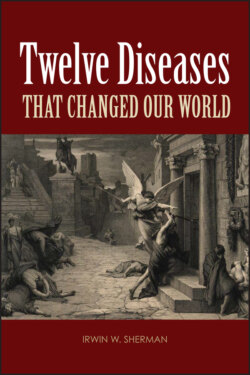Читать книгу Twelve Diseases that Changed Our World - Irwin W. Sherman - Страница 19
Consequences
ОглавлениеThe social and political impacts of the Great Hunger or the Irish Potato Famine (1845 to 1849) were profound. The mass immigration to the United States was so great that today 1 of every 10 Americans is of Irish descent. By 1914 there were more than 5 million Irish-Americans. These immigrants were no longer agricultural peasants working the lazy beds of the bogs but were urban dwellers who came to occupy key positions in railroading, mining, civil engineering, law enforcement, and politics.
Before 1840 the Caucasian population of the United States consisted of Protestants, most of whom came from Britain, The Netherlands, Germany, and Scandinavia; a smaller number of Catholics from France, Spain, Switzerland, and Germany; and very few Irish Catholics. Although the total number of Irish Catholics who emigrated to the United States between 1810 and 1840 was less than 100,000, over the next 25 years the blight-caused famine created a flood of Irish Catholic immigrants, whose numbers exceeded 100,000 per year. These immigrants favored the cities, especially Boston and New York—the ports where they first disembarked. In these urban centers they could constitute as much as 30% of the population. These poor, unskilled laborers with few relatives or homes crowded themselves together in Irish Catholic ghettos, where the priest was their friend and counselor on Sunday and the local politician became their advisor and caregiver for the remainder of the week. The ghetto Irish constituted a voting bloc that could exercise great political influence in the cities in which they lived. Through their social activism and unionization, these immigrants, the poorest of the poor and despised by most in the United States, changed political party platforms, especially that of the Democratic Party—a legacy that persists today. Anti-imperialist policies in America (and isolationism) were fostered by the Irish immigrants largely because of their hatred of Britain. It is thought that it was the effective lobbying efforts by the Irish (which continued to denigrate British imperialism) that delayed U.S. entry into World Wars I and II. The virulent anti-English position of the Irish, the first politically and ethnically integrated group, affected Northern attitudes toward the American South. Indeed, during the Civil War and thereafter, the Irish voted for the hard-line Republicans, not because they were anti-slavery but because they hated the English and the white Anglo-Saxon Protestants (WASPs) who lived in the American South.
Could there be a repeat of the 1845 to 1849 disaster? Possibly. Potato famines, smaller in scale than that of the Great Hunger but certainly not inconsequential, have been recorded. The last major famine due to late blight occurred in 1916 to 1917 and resulted in the death of 700,000 German civilians: the old, the weak, the children. During World War I—the Great War (1914 to 1918)—the copper used in the preparation of Bordeaux mixture was needed for shell casings and electric wire, and without this fungicide, potatoes rotted in the fields. All the grain and the potatoes that remained were commandeered for the war effort, and so the civilians behind the lines were left to feed on turnips or any other foods they could find. In autumn of 1916 the people were hungry, and by winter they were starving. Germany’s High Command assumed that the eastern campaign against a weakened Russian army would be simply a mop-up affair, and, once complete, the plan was to direct the army’s efforts against the Allies on the Western front. That did not happen because there was a saboteur, P. infestans. Many of the rank-and-file German soldiers, knowing of the plight of their hungry, starving, and dying families at home, lost their will to fight. It has been speculated that this weakening of morale was one of the reasons the German High Command was never able to launch a successful campaign on the Western front. Indeed, the German army was forced to retreat and maintain their position on the Hindenberg line. In 1917, British and French forces were joined by the Americans, and a great new military strength could be brought to bear on the German front. But that strength became unnecessary since late blight had already struck a devastating blow against the German Empire. With morale in decline, the military might of Germany began to crumble, and by 1918 it collapsed. The Great War ended when the armistice was declared on 11 November 1918.
Even today in countries such as Russia, where for many people there is little to eat except potatoes, an epidemic of late blight could be catastrophic. When the blight appeared in the 1990s, yields from some Russian plots were reduced by as much as 70%. In countries where fungicide is affordable and is applied, losses can still be as high as 15%. It has been estimated that in developing countries, where fungicides are out of reach because of cost and difficulties in distribution, the annual toll amounts to billions of dollars. What to do? At a minimum, it is necessary to continue to search for new potato varieties that are resistant to blight and develop more effective fungicides, but more importantly it must be recognized that preventing future famines will require both political will and global social responsibility.
